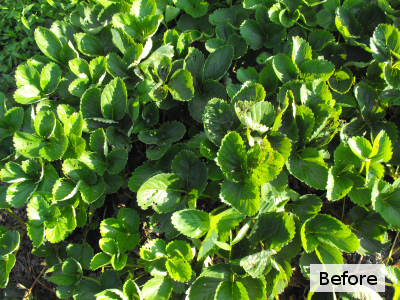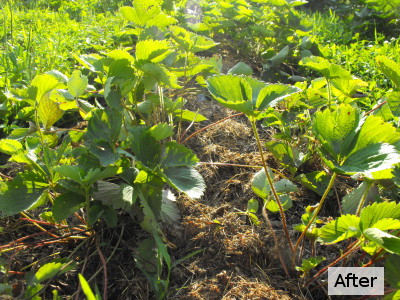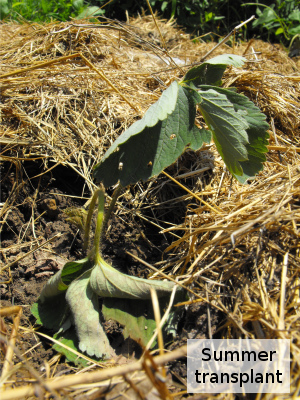
Summer strawberry bed renovation
 When
I first got strawberries, I thought that since they were perennials, I
could just eat fruits every year and mostly ignore the plants. So
I just picked off runners now and then, mulched, and weeded.
Along came the plants' second year of bearing, and the berries were not
as tasty as I remembered. What happened?
When
I first got strawberries, I thought that since they were perennials, I
could just eat fruits every year and mostly ignore the plants. So
I just picked off runners now and then, mulched, and weeded.
Along came the plants' second year of bearing, and the berries were not
as tasty as I remembered. What happened?
The problem turned out
to be multifaceted. I suspect that heavy rains last spring washed
away some of the soluble minerals, resulting in a micronutrient
deficiency.
But it didn't help that I'd let the beds become matted masses of plants
and hadn't given the berries a good top-dressing of compost to make up
for their hard work the year before.
 I've
now tentatively settled on a three year cycle for strawberries.
At this time of year, I pull out any beds that are three years old or
older, then renovate the one and two year old beds. Renovation
consists of ripping up any runners I've let set between the parent
plants and breaking off new runners starting to form. Add a
little manure and some grass clippings, and the plants are ready to
soak up the rays in preparation for next spring's harvest.
I've
now tentatively settled on a three year cycle for strawberries.
At this time of year, I pull out any beds that are three years old or
older, then renovate the one and two year old beds. Renovation
consists of ripping up any runners I've let set between the parent
plants and breaking off new runners starting to form. Add a
little manure and some grass clippings, and the plants are ready to
soak up the rays in preparation for next spring's harvest.
 While
I'm renovating the middle-aged beds, I take a little care to dig up the
best-looking runners and transplant them into new beds.
Transplanting strawberries in the heat of summer is a bit dicey, but
the payoff is large --- you gain enough growth that you can eat plenty
of berries from the beds next spring rather than picking off all the
blooms and waiting until the second spring to taste the crop.
I've found that if I dig the roots up carefully enough, my transplants
will wilt in the hot sun but will be putting up new leaves within a
week.
While
I'm renovating the middle-aged beds, I take a little care to dig up the
best-looking runners and transplant them into new beds.
Transplanting strawberries in the heat of summer is a bit dicey, but
the payoff is large --- you gain enough growth that you can eat plenty
of berries from the beds next spring rather than picking off all the
blooms and waiting until the second spring to taste the crop.
I've found that if I dig the roots up carefully enough, my transplants
will wilt in the hot sun but will be putting up new leaves within a
week.
My hope is that this
three year cycle will keep me sated with my favorite fruit for years to
come. Only time will tell if this method needs more work, but
strawberry yields this spring were heavy and delicious. The proof
is in the pudding --- strawberry shortcake.
The British use the
word "pudding" to mean "dessert", in case this isn't clear.
Want more in-depth information? Browse through our books.
Or explore more posts by date or by subject.
About us: Anna Hess and Mark Hamilton spent over a decade living self-sufficiently in the mountains of Virginia before moving north to start over from scratch in the foothills of Ohio. They've experimented with permaculture, no-till gardening, trailersteading, home-based microbusinesses and much more, writing about their adventures in both blogs and books.
Want to be notified when new comments are posted on this page? Click on the RSS button after you add a comment to subscribe to the comment feed, or simply check the box beside "email replies to me" while writing your comment.
